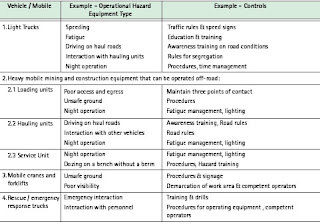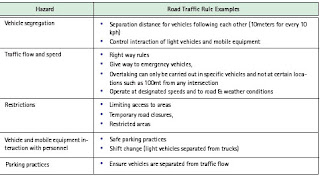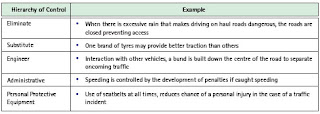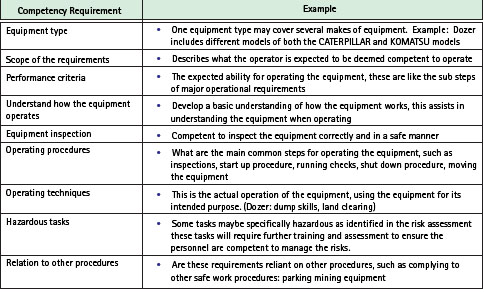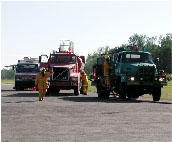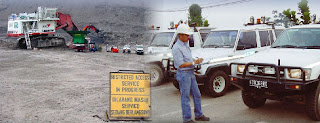A risk assessment must be conducted on each type of vehicle and mobile plant to identify operational hazards to be controlled by the development of operator competency requirements.
Hazard Identification
1. Identify what types of vehicle and mobile equipment need to be assessed
Each type of vehicle and mobile equipment needs to be identified. If you don’t already have a register of all of your equipment, such as a maintenance schedule or similar you will need to create a list of all of your vehicles and mobile equipment. Referring to the register and segregate the vehicles and mobile equipment into similar types. Mobile equipment types:
2. Identify operational hazards associated with each type of vehicle or mobile equipment
What is an operational hazard?
The operation of vehicles and mobile equipment can be definedas working with the equipment. Examples of operation of equipment include inspecting machinery, performing maintenance, using the equipment for its intended purpose. A hazard is a source of potentially damaging energy or a situation that may give rise to a personal injury.
Therefore we can assume an operational hazard is the potential for harm occurring while working with vehicles or mobile equipment. The following are some examples of operational hazards
• Land clearing on slopes
• Dozing on benches without a berm
• Speeding on haul roads
• Operating defective equipment
• Operating equipment without a seatbelt
• Limited operator vision particularly in haul trucks
Techniques for identifying operational hazards
When assessing the vehicles and mobile equipment types ensure that the people conducting the assessment have a good understanding of how the vehicle or mobile equipment is used. It is beneficial to have experienced operators and supervisors as part of the risk assessment team. Have consideration for where, how, and who is expected to operate the vehicles and mobile equipment. When identifying operational hazards the following techniques can be useful;
• Review past incidents
• Group discussion & brainstorming with experienced operators of equipment, supervisors and experienced trainers
• Review experience from other mining operations
Risk Assessment & Control
You will now have a list of vehicle and mobile equipment types and a list of associated operational hazards. Complete a risk assessment to determine controls to be put in place to manage the risk exposure. All identified operational hazards and their controls must be incorporated in to operator competency requirements to ensure that all operators are suitably trained and aware of requirements.
Operational procedures and operator competency criteria must be developed for all activities which require a high degree of operator skill to manage the risk. (e.g. Land clearing, dozing on benches without a berm)
Operational Procedures and Competency Criteria
In some cases one of the identified controls for managing an operational hazard is to ensure that a highly skilled person is operating the equipment. It is assumed that a novice or trainee will not have the adequate level of skill to safely perform the task. In this case an operational procedure (documented process for the specific task) must be developed to provide a consistent method for the highly skilled operator to follow.
Firstly develop the operational procedure for the task, this should be developed in consultation with experienced operators. Use the operational procedure to list the main tasks that need to be completed; use the list to summarise the operator competencies that are required. When an operator is deemed competent they shall have a minimum level of knowledge and demonstrated skill to safely carry out the task. For further information on what should be included in operator competencies refer to Operator Competency Requirements in Section 4.2 Selection, Training, Competency & Authorisation.
Risks identified with vehicle interactions, within mining and non mining areas, must be controlled by the development of road traffic rules that address:
• vehicle segregation (following distances)
• traffic flow and speed (right of way, overtaking, speed limits)
• restrictions (limiting access, temporary road closure, restricted areas)
• vehicle and mobile equipment interaction with personnel (spotters, mechanics, shift change) parking practices
Risks associated with vehicle interaction will need to be identified in a comprehensive manner and reviewed on a regular basis (annually). Risks can be identified by:
• reviewing safety statistics (near misses, hazard reports, incidents, injury, investigations)
• risk assessment focused on the interaction of vehicles
• brainstorming ideas and concerns with vehicle or mobile equipment operators for their opinion and experiences of what needs to be managed.
Road traffic rules will need to be developed to assist in managing risks associated with vehicle interaction such as:
Any risk identified as having a potential to cause a fatal incident must be controlled before the vehicle or mobile equipment is operated, or before road traffic rules are authorised for change.
When a risk is identified as having a potential to cause a fatal incident, you are required to reduce the risk to as low as reasonably practicable. The hierarchy of control options can be used for the control of risk. The type of control that is used in any set of circumstances will depend upon
• the nature of the hazard,
• the nature of the workplace and
• the availability and suitability of different types of controls
In many cases several hierarchy of control options are used to manage the risk effectively.
Examples of risk controls:
Ensure all affected personnel are notified within a suitable time frame of the risk and what controls are in place (short or long term) any changes to road traffic or operating practices must be completed.
Selection, Training, Competency and Authorisation
The recruitment process shall ensure:
- criteria for medical fitness and health of personnel required to operate vehicles and/or mobile equipment is established and followed
- personnel are qualified and have appropriate experience in occupations where they are required to operate vehicles or mobile equipment
Medical Fitness and Health Requirements
Criteria for medical fitness and health of personnel who operate vehicles or mobile equipment needs to be developed. This ensures the employees safety while operating the vehicle or mobile equipment and also ensures co workers safety by not inadvertently exposing them to a higher operational risk.
Review the competency requirements for the operation of vehicles or mobile equipment for requirements that rely on a specific level of medical or physical fitness, health and mental capabilities, for example;
- a common medical requirement for all drivers and operators is the need for good eyesight. Therefore if a person is required to wear glasses, then that becomes a condition for maintaining their KIMPER.
- physical fitness may require a person to be able to lift loads on to a truck, therefore the person would need to be fit healthy and not have a pre existing condition that may flare up, due to lifting such as a bad back.
- mental capabilities can include the ability to calculate safe work loads for cranes etc.
A policy or guideline should be developed which outlines the responsibilities of the employee and supervisor regarding the use of medication at work, for example some cold and flu tablets make people drowsy, which can be detrimental to the operation of any equipment. It is a KPC requirement to have a doctor’s certification stating, personnel are medically fit to operate vehicles or equipment.
Operator Qualifications and Experience
The operator competencies shall provide a list of the required qualifications and experience for operating specific vehicles or mobile equipment. The risk assessment will have identified controls for managing hazardous tasks and should list what amount of experience is necessary to operate the vehicles or mobile equipment.
When a person is being recruited, they will need to be assessed to ensure they are capable of meeting the competency and health requirements specific to the equipment they are expected to operate. This may include a probation period especially if the person requires training. Personnel conducting training in the operation of vehicles and mobile equipment must be:
- assessed as competent in performing training
- deemed competent and have a minimum of 3 years experience operating the equipment in which they train personnel for
- reassessed annually by KPC
It is important that personnel conducting training in the operation of equipment are competent trainers and understand the operational requirements of the specific equipment in the field. These trainers are responsible for the level of competence the trainees achieve; and therefore control the skill level and understanding of personnel operating the equipment on the mine lease.
Trainers must be deemed competent to train, (trainer the trainer course or similar). The company will need to determine what level of training is acceptable and ensure that it is included in the competency requirements for trainers The trainer must have experience in operating the equipment which they are training personnel in. The amount of experience the trainer has can be determined by a log book of hours or employment records.
Operator competency requirements must be identified for each type of vehicle and mobile equipment that has been approved for use at KPC. These competencies must incorporate the following functions:
• equipment inspection ( Pre – operation checks )
• operating procedures ( Start up/ operating / shut down procedures )
• operating techniques ( application of equipment / procedures)
• specific skills for hazardous tasks (land clearing, dozing on benches without berm etc)
Operator Competency Requirements
The vehicle and mobile equipment type register will provide a list of operator competencies that need to be developed such as light vehicles, haulage units or rescue vehicles. The competency criteria are usually developed by the human resource department in consultation with experienced personnel with consideration for the completed risk assessment, operator manuals, manufacturer, legal. A template which includes the following key functions will need to be developed to ensure that standard and comprehensive competency requirements are made available. Key functions to be addressed:
The training and competency assessment system shall ensure:
- competency standards for persons required to operate each type of vehicle and mobile equipment
- defensive driver training for personnel required to transport personnel
- restricted operations of equipment (eg maintenance personnel to operate heavy mobile equipment)
- training and formal competency assessments for the above personnel
- personnel required to operate vehicles and mobile equipment have safe operating techniques reinforced on an annual basis
- the recording of all training undertaken, and results of competency assessments
- annual re-assessment of competencies and retraining when required
In order to obtain a pit access pass:
• a request must be approved by the General Manager or his delegate.
• the person is required to drive in the pit more than once in a two week period
• the person must be trained and deemed competent in the Pit Traffic Rules
Training and Competency System
A training and competency system for personnel required to operate vehicles and mobile equipment needs to be implemented, this is to ensure:
• standards are developed and implemented for all types of vehicles and mobile equipment
• associated high risk tasks have suitable controls in place
The training and competency system will cover the development of competency criteria, an assessment process for ensuring the operator is appropriately trained to meet all operator requirements, refresher training and re-evaluation of competencies on an annual basis. Operators will need to be trained to manage high risk tasks associated with the vehicle being operated, for example:
- defensive driver training for personnel required to transport personnel (eg troop carrier, bus or man haul drivers)
- restricted operations of equipment (maintenance personnel are able to operate heavy mobile equipment)
The refresher training and annual re-evaluation of competencies is required to ensure operator skills are maintained to a suitable safe level for operation. HRDS manages and provide some training courses; it is the department manager’s responsibility to ensure all staff are appropriately trained for their job and that they attend required refreshers to maintain the KIMPER status.
Communication and Awareness
Awareness information and/or instruction must be provided on a regular basis to personnel who operate vehicles and mobile equipment, including reinforcement of :
• critical aspects of safe operation (braking, steering, seat belts, emergency procedures)
• information regarding haul roads / traffic routes / emergency pick up points
• requirements related to operating conditions / traffic rules
• specific skills and/or procedures for hazardous tasks / activities (land clearing)
Awareness Information and Instruction
Information or instruction must be provided to personnel on a regular basis, the purpose of this is to:
- review areas that maybe identified as high risk (this maybe site wide or specific to your work team),
- refresh information to personnel when a trend in reported incidents is identified
- maintain focus and heightened awareness of employees
Information should be provided in a form that all employees at the workplace can understand. Methods should be developed so that employees regardless of language or literacy levels can be provided with information. This can be accomplished using verbal (safety meetings, radio) or visual (posters, monthly banners, and short movies) methods. The dissemination of information on vehicles and mobile equipment is going to vary according to what type of vehicles or mobile equipment is owned and operated.
Presentations can be conducted at weekly safety meetings to disseminate information that applies to everyone in the team such as changes in traffic rules, or where an incident trend needs to be improved. Other information should be discussed at the job or as part of a feedback process for complying with road rules. Information regarding hazardous tasks is more beneficial when reviewed & discussed prior to completing the job.
Awareness Information:
Work Method and Condition Control
Safety practices shall be defined which ensure:
- no person can operate vehicles and mobile equipment without a valid KIMPER for that vehicle or mobile equipment.
- the operator and all passengers wear seat belts at all times
- no vehicle approaches within 30 meters of mining equipment without first making positive contact with the operator of that equipment
- management of identified risks associated with traffic and personnel interaction such as spotters, mechanics and shift change
Overtaking must be made with caution and only when it is safe to do so, by ensuring:
- no overtaking within 100 meters of any intersection
- no vehicle may overtake a haul truck or water truck without making positive contact and receiving permission from the heavy vehicle
Vehicles and mobile equipment must only be towed by operators that have been instructed in the towing procedures, under the supervision of maintenance staff.
Some safety practices are specific to the type of equipment being operated while other safety practices as described below are applied to all personnel operating equipment and must be complied with.
- Ensure that only personnel with a valid kimper are allowed to operate the relevant vehicle or mobile equipment.
- Maintain a current register of trained operators for each type of equipment and only use those persons.
- The wearing of seat belts is a mandatory requirement for all operators and passengers in vehicles or mobile equipment. This requirement needs to be reinforced regularly and checked for compliance in the field
- Overtaking and approaching mining equipment procedures are explained in the appropriate induction, it is the responsibility of the company to reinforce and monitor compliance to these rules. Include these checks in PRINASA’S or planned observations.
- Some personnel are required to work around operating vehicles & mobile equipment. Positions such as mechanics and spotters are exposed at a higher rate than other personnel.
Suitable controls will need to be developed to ensure that the risk is minimised to an acceptable level. Some examples are:
• all personnel to wear reflective vests in the pit,
• all personnel to maintain communication via radio to operators,
• having a specific area for shift change
• placing safety cones around a vehicle that has broken down
• Towing procedures will need to be developed for each of the following;
• selection of suitable towing equipment
• towing the equipment if inoperable
• for towing a load
• maximum load to be towed, including tow point ratings
• direction of pull
Operating and traffic rules for all vehicles and mobile equipment shall consider:
• Kepmen555-Decree of Mines Articles 142 / 145 / 146
• Kepmen555-Decree of Mines Articles 250 / 251 / 252 / 254
For a copy of Kepmen555-Decree of Mines Articles 142 / 145 / 146 / 250 / 251 / 252 / 254 refer to appendix B
Emergency Controls
There must be instruction and practical exercises to ensure:
• emergency vehicles using flashing lights and sirens are given right-of-way
• emergency response to tyre or engine fires, brake, steering, or radio failure
• emergency muster points and emergency escort points are known
• general emergency awareness – red light process and emergency pick up points
Emergency Planning is necessary to prevent further loss or injury should an incident occur. Emergency planning is required in two areas of vehicle and mobile equipment operation,
- specific emergency controls for the type of vehicle or mobile equipment and
- emergency controls for road traffic interaction
The specific emergency response requirements for the particular type of vehicle or mobile equipment will be part of the operator competency requirements. In this case operators will be required to know how to respond to engine fires, brake or steering failure.
Other more general emergency requirements that involve road traffic interaction shall be covered in the general road rules and pit traffic rules. Operators must be deemed competent in the pit traffic rules prior to operating in the pit, this will include understanding the following emergency requirements:
- emergency vehicles using flashing lights and sirens are given right of way
- emergency muster points and emergency escort points are known
- general emergency awareness – red light process and emergency pick up points
A program will need to be developed to ensure all operators are instructed in relevant and appropriate emergency procedures. Part of this training may take place during the induction and other more specific emergency training may occur on an individual basis and would cover topics such as specific operator emergency training.
Practical exercises will also need to be included in the emergency training program. Practical exercises provide operators with an opportunity to put into practice the emergency theory they have learnt. Develop a schedule for conducting the practical exercises and ensure a review is carried out of the exercise including feedback from the participants to identify opportunities for improvement.
Monitoring, Inspections and Audits
A traffic control program shall monitor the performance of vehicle and mobile equipment operation, including the monitoring of:
- operators holding appropriate KIMPER
- adherence to road traffic rules ( eg speed limits, wearing of seat belts)
- equipment operation in compliance with KPC General Traffic Rules and/or Pit Traffic
Rules at all times
- the method to administer breaches of traffic rules
Task observations must be performed in order to monitor vehicle and mobile equipment operation and compliance to road traffic rules, methods include:
• Planned Task Observations
• PRINASA’s
Traffic Control Program
A program needs to be developed that observes and checks that the correct operation of vehicles and mobile equipment is occurring. By monitoring the level of compliance to road traffic rules valuable information is gathered which provides an indication of the level of compliance by drivers to the rules. This information can be used to determine if training is satisfactory, or identify level of obedience by drivers to the traffic rules.
1. Identify what vehicle and mobile equipment interaction requirements apply to your type of work.
Are you only required to drive on access roads, or is the majority of your work performed in the pit?
The following are examples of what requirements will need to be assessed for compliance.
• Operator has the appropriate licence to operate vehicle or equipment (KIMPER)
• Compliance to
• KPC General Traffic rules
• Pit Traffic rules
2. Determine how frequently the requirement needs to be assessed for compliance. Depending on your exposure will impact on how often you check compliance, some requirements may require ongoing monitoring to ensure all employees have the correct KIMPER for the job. While Pit traffic rules may be checked on a monthly schedule.
3. Select personnel to carry out the monitoring, for example supervisors would monitor their work team. Other forms of monitoring can apply to the entire site such as speeding or checking of KIMPERS at the security check points.
4. Select an appropriate tool to monitor compliance to the requirements; you may need to use a different tool for different requirements or for monitoring specific areas of a requirement. Make sure personnel are trained in the monitoring process such as PRINASA or Planned Task Observations.
Each Division will use vehicles and mobile equipment in a manner specific to their work requirements. This means that the Mining Operation Division would have a higher risk exposure to driving in the pit compared to the Commercial or Human Resources Divisions. By considering the specific exposures that apply to the Division or Department monitoring of compliance to operational requirements will vary and so will the tools used.
Example:
5. Prior to monitoring compliance to road traffic rules and operation requirements a method will need to be developed for dealing with personnel who breach the requirements and determine penalties for not complying.
For example Golden Rule 4: Road safety and traffic rules.
- All occupants of vehicles and mobile equipment must wear seat belts at all times whilst the equipment is being operated. This includes drivers and passengers
- Penalty: First offence – Final Warning
- Second Offence – Termination of employment
- Every driver must adhere to the speed limits set for the area, vehicle or equipment being used.
- Speeding by more than 30kph over the limit – Maximum Penalty: Termination of employment.
Reporting Assessment and Corrective Actions
Speed limits and traffic rules shall be reviewed annually to ensure applicability to changing conditions. Hazards or defects identified with vehicles and mobile equipment or road condition must be reported, assessed and corrected. This will include:
• actions required to stand down equipment requiring repair of defects (faulty brakes, steering, seat belts)
• actions required to warn users or close roads to traffic
• the recording of actions taken to correct the hazard or defect
Breaches of road traffic rules must be reported, assessed and corrected. This must include:
• implementing the corrective and/or disciplinary actions required
• requirements for the manager to lead an investigation of breaches with a fatality potential
• the recording of actions taken to correct the traffic rule violation
Identifying Hazards or Defects
Hazards or defects can be identified with vehicles or mobile equipment, when conducting prestart or weekly checks, during operation, or while servicing or performing maintenance. Hazards or defects in road conditions will generally be identified while the road is in use or when there is a change in external conditions such as heavy rain.
Hazards and defects can be identified at various times and locations, therefore a system needs to be developed which can ensure the hazards and defects can be reported, assessed accurately and addressed in a reasonable time frame.
Reporting the Hazard or Defect
All personnel are required to report any hazard or defect they find. Appropriate reports to collect information on hazards and defects associated with vehicles, mobile equipment and road conditions can be:
• Hazard report
• Vehicle or Mobile Equipment Prestart checklist
• Vehicle or Mobile Equipment Weekly checklist
• Maintenance/inspection report
• Out of service tag
If the hazard or defect renders the equipment unsafe, it must be isolated and an out of service tag attached as soon as possible to prevent other operators, using the equipment. If the full implications of the defect are unknown, then seek advice from your immediate supervisor. If the supervisor is advised of the defect, they should check the defect has been appropriately tagged and isolated. Then decide on appropriate further actions. Some vehicle or mobile equipment conditions require the vehicles to be stood down from operation until the issue has been fixed other conditions do not need to be stood down but will need to be repaired.
Examples:
If there is a problem with road conditions, then a method must be in place for the hazard to be raised as soon as possible, to prevent an incident occurring. The hazard can be raised via verbal communications to the shift supervisor or if not an immediate problem it may be raise using a hazard report or similar. Contractors will need to identify a method to pass information if the problem is reported directly to them.
A method will need to be developed for assessing the hazard or defect and what action will be taken to stand down the vehicle or mobile equipment until the problem is fixed. The method used for assessing the hazard or defect must consider how;
• the equipment can be moved safely so it doesn’t create a further hazard
• to effectively isolate the equipment to prevent it being operated while out of service
• is there any immediate danger to other operators, if so how can this be prevented
The method used for correcting the problem must ensure:
• it is recorded in maintenance records
• follows manufacturers or best practice requirements
• is completed by a competent person
• is certified for use by a competent person prior to being used again
Breaches of Road Traffic Rules
Breaches of traffic rules may be identified by purposely going out to identify them (example: using the speed gun to identify people exceeding the speed limit) or they may be noticed while performing other duties. A process needs to be developed so that depending on how the breach is identified it can still be reported and action taken.
In some cases penalties are already in place for breaches of safety rules, in other cases corrective actions will need to be defined. In cases where the breach of a safety rule is assessed as having a fatality potential it is necessary for the manager to investigate the incident to identify how this can be prevented from reoccurring.
Appendix
Appendix A: Developing standards of competence
Competency requirements for vehicles and mobile equipment are developed to ensure that personnel operating the vehicle or mobile equipment are adequately qualified, capable, and have the ability to perform all required tasks in a safe manner including hazardous tasks.
Appendix B: Kep Men 555
Article 142
Driver Qualifications and Obligations
(1) A person may operate a vehicles at a mine where the following requirements have been fulfilled :
a. must be no less than 18 years of age;
b. must have been appointed by the Technical Mine Manager to drive specific vehicles and
c. must have been given training and have been declared a competent driver by the Technical Mine Manager.
(2) A driver of any vehicle equipped with a tipping body shall ensure that if the body is raised for any purpose other than routine unloading it shall be secured by the independent devices provided.
(3) The driver shall make use of any equipment provided at the unloading dock to prevent the said vehicle from overturning, rolling or moving.
(4) Any driver at any mining operation shall comply with the traffic signs as stipulated by the Technical Mine Manager.
(5) Before leaving the vehicle, the driver shall be sure that the vehicle is turned off and locked and safe thus preventing accidental motion.
(6) Prior to travelling along descending roads, the vehicle shall always be driven slowly and using the lowest gear at all times, except where the said vehicle is being towed.
(7) A driver shall not set any vehicle in motion before giving audible warning and ensuring that no person is in the danger area of the vehicle.
(8) At the beginning of every work shift every driver shall undertake an inspection of the outer parts of the vehicle and test the controls and particularly the braking capability.
Article 145
Stockpiles
(1) Whenever waste or minerals are stockpiled, such work shall be supervised to ensure that the stockpiling vehicle remains only in designated areas.
(2) Over edge tipping by vehicles should be avoided and a berm or heap of material maintained at the tip edge.
(3) Where over edge tipping is permitted stop blocks should be provided to prevent vehicles from overturning or over running the tip edge.
(4) Stockpiling work shall be supervised by a stockpiling supervisor who shall designate stockpiling sites, supervise vehicles moving in reverse and shall be responsible for the inspection of the sturdiness of the stockpiling cliff edge.
(5) Stockpiling work shall be avoided when dark or at times of an unclear field of vision except where lighting is provided which guarantees safety and a clear field of vision.
(6) The driver shall remain in the vehicle at the stockpiling area.
(7) Only stockpiling supervisors shall be permitted to be at the stockpiling area and the said supervisor shall bear a brightly coloured fluorescent coat.
Article 250
Operator Requirements
(1) Operators of earth moving equipment at any mining operation shall meet the following requirements :
a. be no less than 21 years of age;
b. have been declared both mentally and physically in good health by a doctor and
c. be in possession of an operating license issued by the Chief Mine Inspector or by any other authorised employee on behalf of the Technical Mine Manager.
(2) The operating license as required by paragraph (1) letter c may only be granted after the person applying has successfully passed an operation examination carried out by the mining company concerned.
(3) The operating license shall only apply in the mining operations area where the said document was granted.
Article 251
Prohibitions Against Passengers
(1) The operator shall prohibit any person from being on any earth moving equipment in operation, for the purposes of inspection, supervision, maintenance, repair work or upon the instruction of an authorised trainer.
(2) It is prohibited for any person to board or to alight from any earth moving equipment which is still operating.
Article 252
Parking Earth Moving Equipment
(1) It is prohibited to leave unattended any earth moving equipment except when the parking brake has been applied, the bucket or knives have been lowered to ground level and the machine turned off.
(2) When an earth moving equipment is parked on an incline, chocks shall be used under the wheels or the said equipment shall be directed toward the roadside or embankment and the bucket and knives shall be lowered to ground level.
(3) When an electrically operated earth moving equipment is to be left unattended, the master switch shall be turned off and all of the controls shall be set to neutral and the parking brakes shall be applied.
(4) When any earth moving equipment is parked at any place which may be dangerous to other traffic the parking lights shall be turned on as well as other hazard indicators.
Article 254
Equipment
(1) The soil conditions at the location where the earth moving equipment is operating shall be adequately strong and in a safe and stable condition. To prevent accidental movement during loading, the loader shall be secured with safety chocks.
(2) The area within the work radius of any earth moving equipment shall be free from obstructions and is prohibited for any person to be within the said area.
(3) Prior to operating any earth moving equipment, the operator shall first sound an audible warning.
(4) Earth moving equipment shall be operated in accordance with the manufacturer’s instructions with regard to the work load, speed, engine Rpm’s and inclination of work sites.
(5) It is prohibited to swing the dipper or the bucket above the cabin of any transport vehicle until the operator has left the cabin and is in a safe place, except where the said vehicle is specially designed to protect the operator from falling objects.
(6) It is prohibited to use earth moving equipment to lift or transport hazardous materials.
(7) Where earth moving equipment is moving to another location, the digging equipment or excavating bucket shall be lifted just above the ground so as not to interfere with the operator’s view. In the case of draglines, the bucket shall be kept as close as possible to the boom.






